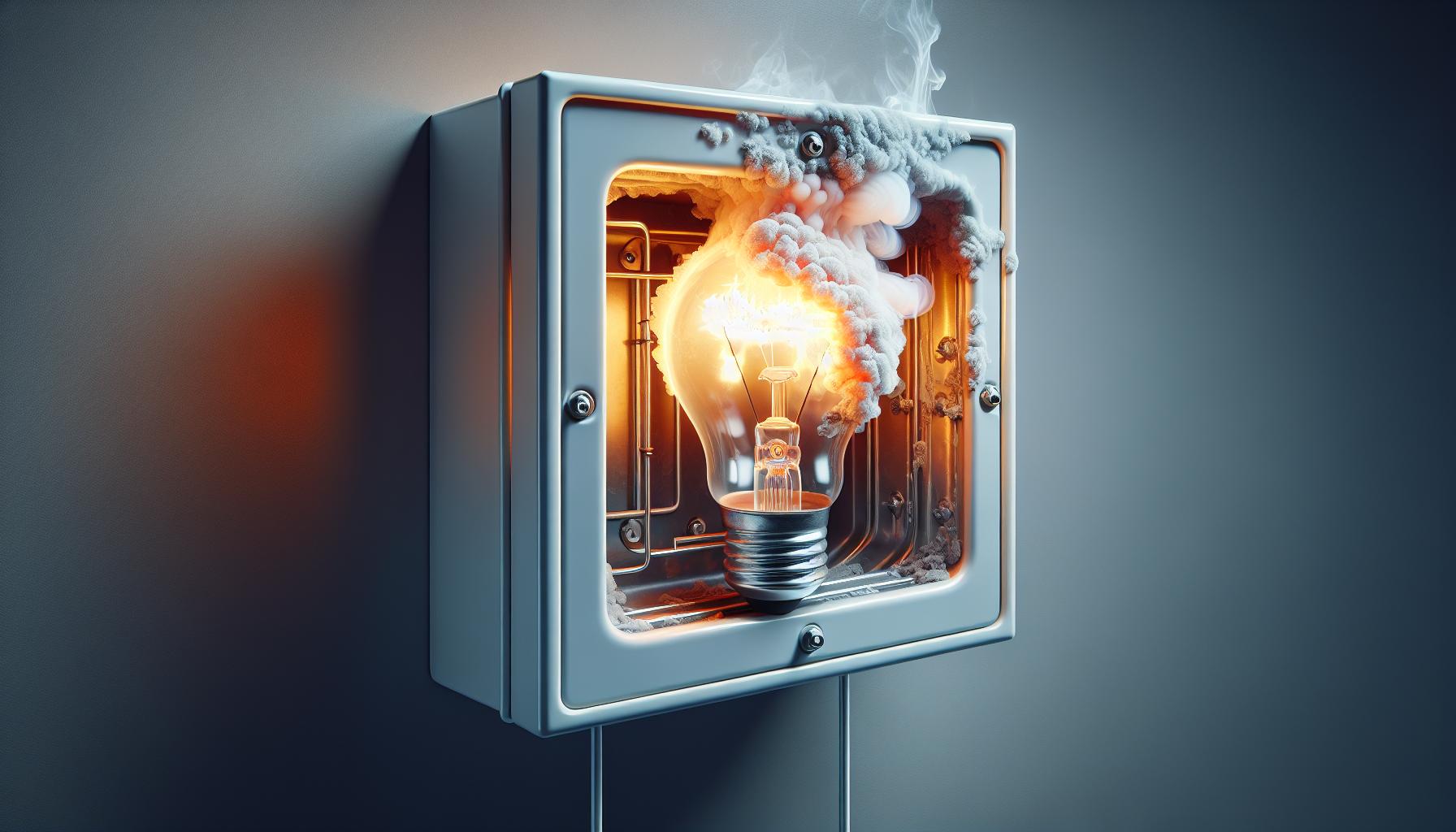Ever had a light bulb pop with a startling bang? It’s not just you—it happens more often than you’d think. But why do these silent illuminators suddenly turn into mini fireworks?
Factors that contribute to light bulbs exploding
When you’re knee-deep in a home DIY project, the last thing you want is for your work to be literally shattered by a popping light bulb. Understanding why a bulb can go from a trusty source of light to a burst of glass could save you from a startling interruption, or worse, injury.
One primary culprit for bulb blowouts is Voltage Fluctuations. Your home’s electrical system is designed to handle a certain voltage. When this fluctuates significantly, your bulb can endure more electrical current than it’s meant to hold, leading to overheating and potentially, a loud pop. It’s like inflating a balloon beyond its limit; eventually, the stress is too much.
Another factor is Poor Bulb Quality. Imagine you’re painting a room; if you use low-grade paint, the result can be less than stellar. The same goes for light bulbs. Cheaper materials and construction often lead to a shorter lifespan and a higher risk of explosion. In other words, you get what you pay for.
Incorrect Bulb Wattage also plays a role. If you throw a 100-watt bulb into a fixture that’s only rated for 60 watts, you’re asking for trouble. That extra power generates more heat than the fixture can manage, which can make the glass prone to breaking. It’s like trying to fit a big couch through a small door; something’s got to give.
Insulation Contact is a lesser-known concern. Certain ceiling fixtures are designed to be “IC,” meaning they can have direct insulation contact without risk. However, using non-IC rated fixtures and bulbs covered with insulation can lead to overheating because the heat has nowhere to escape. This is akin to wearing a winter coat in summer – you’re bound to overheat.
Lastly, we can’t overlook the role of Defective Fixtures. Just as a shaky ladder won’t bode well for your renovation efforts, a fixture with faulty wiring or damage can spell doom for your bulb’s lifespan.
Remember, when it comes to DIY projects and home lighting, taking precautions and choosing the right materials are just as important as the aesthetic appeal. Keep these factors in mind to ensure that your room’s ambiance isn’t spoiled by an unexpected light bulb pop.
Understanding the construction of a light bulb
Light bulbs aren’t just glass spheres glowing with light; they’re intricate devices that play a pivotal role in our daily comfort and productivity. To get a better handle on why bulbs may explode, let’s break down their construction.
Each bulb consists of several components:
- Glass enclosure: This provides a protective environment and is often filled with an inert gas like argon.
- Filament: Usually made of tungsten, this is the part that gets heated and emits light.
- Base: Typically brass or aluminum, it connects the bulb to the electrical source.
- Support wires: They hold the filament in place and deliver electricity.
The design of a light bulb is such that the filament, housed within the glass enclosure, heats up when electricity flows through it. The interior of the bulb is usually a vacuum or filled with an inert gas to prevent the filament from oxidizing and breaking down too quickly.
Why is the filament made of tungsten? It’s all about the melting point. Tungsten has one of the highest melting points among metals, enabling it to glow white-hot without melting. This characteristic is fundamental for the durability and function of the bulb.
Understanding the materials is crucial for DIY enthusiasts and lighting aficionados. You’re used to handling different fixtures and bulbs, and knowing what you’re working with can make all the difference. The glass, for instance, must tolerate the intense heat generated by the filament. If it’s too thin or of poor quality, the risk of a bulb explosion increases under stress.
« What Light Bulbs Are Most Energy Efficient? Shocking Truth Revealed
What Light Bulbs Are Best: Illuminate Every Room Perfectly »
Moreover, the inert gas within the bulb not only extends the life of the tungsten filament but also reduces the evaporating tungsten from depositing on the bulb’s glass, which could cause hotspots.
Overheating as a common cause of explosions
When you’re dealing with light bulbs, one of the primary culprits for unexpected pops and bangs is overheating. It might surprise you, but overheating can result from a few different scenarios, and it’s crucial to be aware of each.
Firstly, there’s the issue of improper wattage. If you’ve ever popped a bulb into a fixture without checking the wattage requirements, you’re playing with fire, sometimes quite literally. Here’s the deal: fixtures are rated for specific wattages, and exceeding that rating can lead to overheating. It’s like trying to run a marathon in shoes that are too small – something’s going to give, and with light bulbs, that something is usually structural integrity.
Another heat-related problem comes from the bulb’s environment. Poor ventilation in a light fixture, like an enclosed dome or lantern, can trap heat and bake the bulb. Remember, bulbs need to breathe too – in their own way. When they’re boxed in without proper air circulation, the heat builds up, and the risk of an explosion increases.
It’s also worth mentioning that loose connections can contribute to overheating. A bulb that’s not screwed in properly can lead to electrical arcs – tiny lightning strikes inside your fixture that generate a lot of heat. Pair that with the heat already being produced by the bulb, and you’ve got a recipe for a light bulb grenade.
Switching to LED bulbs could be a smart move, as they tend to operate at cooler temperatures and have less risk of overheating compared to traditional incandescent bulbs.
While you’re admiring the glow of your light bulbs, keep in mind that the silent dance of electricity and elements is a delicate one. Overheating is a sneaky adversary in the life of a light bulb, but with proper care and attention, you can prevent it from cutting the performance short.
The importance of voltage regulation
Voltage regulation in your home might not be something you think about often, but it’s crucial when it comes to the health and longevity of your light bulbs. Excessive voltage can push a bulb beyond its designed limits, causing overheating and ultimately leading to explosions or short life spans.
Voltage fluctuations are normal to a degree, but consistent high voltage is a recipe for disaster. As a home DIY enthusiast, you’re probably keen on ensuring everything operates smoothly and safely. That’s why it’s vital to understand how your bulbs react to changes in voltage.
Here’s the thing: light bulbs are designed to handle a specific voltage. When the supplied voltage goes above this, the bulb’s filament can heat up excessively. Think of it like pushing your car to its max speed for a prolonged time – pretty soon, something’s going to give.
So, how do you keep tabs on voltage? Invest in a voltage tester or multimeter. These handy tools allow you to check the voltage coming into light fixtures. If you find that the voltage is chronically high, this isn’t a DIY fix – it’s time to call in an electrician. They can install a voltage regulator that can correct these surges and protect your bulbs.
Also, consider the type of bulbs you’re using. LEDs not only handle fluctuations better than incandescents, but they also work more efficiently within a range of voltages. As an upgrade from older technology, they’re a smart choice.
Remember, voltage isn’t something you can see or feel, but it’s always there and it’s always affecting your home lighting. By staying proactive and making sure your home’s voltage is regulated, you’ll save money on replacements and maintain a brightly lit, safe environment. Keep this often-overlooked aspect of home maintenance on your radar to ensure your light bulbs function at their best for as long as possible.
The role of poor manufacturing in exploding light bulbs
While you’re keeping an eye on voltage fluctuations, don’t overlook the impact of manufacturing defects on your light bulbs’ propensity to bid an explosive farewell. Even with perfect voltage regulation, poor construction quality can leave your bulbs vulnerable. Here are a few factors where manufacturing may drop the ball:
- Glass Quality: Low-grade materials can introduce weaknesses in the bulb’s glass, making it more susceptible to cracking under the pressure of everyday use.
- Filament Placement: The filament needs precise positioning within the bulb. If it’s too close to the glass, it can cause hotspots that weaken the bulb and increase the risk of shattering.
- Gas Composition: An improper mix of gases inside certain types of bulbs can influence how they burn and ultimately lead to premature failure or even explosions.
Sometimes, these flaws pass unnoticed due to insufficient quality control during production. If a batch of bulbs misses a critical inspection, imperfections could make it into your home. You’re a savvy DIY enthusiast, so don’t hesitate to inspect each bulb before installation for any signs of external damage or anomalies.
Moreover, bulbs that have traversed long distances to reach your local store have a higher risk of unseen damage. Bumps and jostles along the supply chain can microfracture the glass or dislodge the filament. Yes, even the journey from factory to living room can spell doom for a delicate bulb.
Regularly swapping out older bulbs for new ones might seem like a solution, but you’re better off choosing high-quality bulbs from reputable manufacturers in the first place. While the up-front cost might be higher, you’ll likely save on replacements and avoid the startling bangs of unexpected bulb breakage. Keep this critical info in mind the next time you’re browsing the lighting aisle, and choose brands that prioritize quality and durability over a slightly lower price tag.
Conclusion
Understanding the reasons behind light bulb explosions can save you from a startling pop and the inconvenience of premature replacements. Remember to give your bulbs a once-over for any irregularities and stick to those that come from trusted brands. With this knowledge tucked away, you’ll not only ensure a safer home but also enjoy the true lifespan of your light fixtures. Stay bright and stay safe!
Frequently Asked Questions
Why do light bulbs explode?
Light bulbs can explode due to several factors including power surges, loose connections, moisture, or a damaged light bulb socket.
What are the signs of a faulty light bulb?
Signs of a faulty light bulb include flickering, decreased brightness, discolored glass, or unusual noises when the bulb is switched on.
How can power surges cause light bulbs to explode?
Power surges can cause an excessive current to flow through the bulb, heating the filament rapidly, leading to a potential explosion.
What should be done to prevent light bulbs from exploding?
To prevent explosions, ensure bulbs are properly installed, use bulbs with correct wattage, inspect for damage before use, and opt for high-quality bulbs from reputable brands.
How does poor manufacturing affect light bulbs?
Poor manufacturing can lead to low-quality glass, improper filament placement, and incorrect gas composition, which increase the likelihood of bulb explosions.





